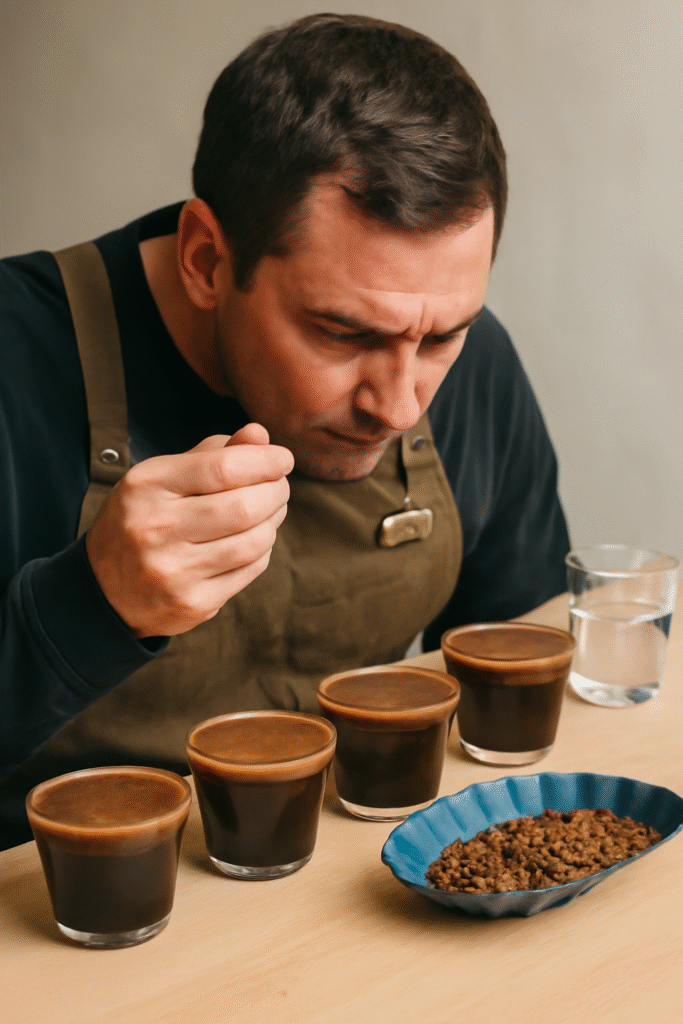Have you ever wondered how coffee professionals judge whether a coffee is “good”? Or how roasters decide which beans to buy? The answer lies in a ritual called cupping—a structured tasting method that’s as essential to the coffee world as grapes are to wine. But what is cupping really, and why does it matter so much?
What exactly is cupping?
Cupping is the standard method used in the coffee industry to evaluate the quality and flavor profile of coffee beans. It involves brewing ground coffee in a controlled way and tasting it using specific steps to identify attributes like aroma, acidity, body, sweetness, and aftertaste. It’s not just a tasting—it’s a sensory evaluation technique used globally by farmers, buyers, roasters, and baristas.
Why is cupping so important?
Cupping is the coffee industry’s universal language. It ensures that everyone—from farmers to roasters to importers—can discuss and assess coffee in a consistent way. It helps identify defects, recognize exceptional quality, compare harvests, and make informed decisions on pricing, roasting, and sourcing. Cupping also plays a major role in competitions, certifications, and quality control across the entire supply chain.
Who participates in cupping sessions?
Cupping isn’t limited to elite professionals. It’s used by a wide range of people in the industry. Farmers cup to test different processing methods. Importers and exporters cup to compare lots and select what goes to market. Roasters use cupping to refine roast profiles and ensure consistency. Even baristas and café owners use it to understand what they’re serving. Increasingly, curious consumers are joining in too—learning more about their favorite beans through hands-on tasting.
How is a cupping session conducted?
The process is highly standardized. Coffee is ground to a medium-coarse texture and placed into small cups or bowls. Hot water is poured over the grounds, and the coffee steeps for about four minutes. Then, a spoon is used to break the crust of floating grounds, releasing intense aromas. After removing the top layer of foam, tasters slurp spoonfuls of coffee to evaluate its flavors and mouthfeel. Slurping isn’t rude—it helps spread the coffee across the palate for better sensory analysis.
What do tasters look for?
Cupping focuses on key sensory attributes. Aroma, both dry and wet. Flavor, or the overall impression of the coffee’s taste. Acidity, which adds brightness and liveliness. Body, the weight or thickness of the liquid on the tongue. Sweetness, which indicates quality and ripeness. Aftertaste, or the finish. Balance, uniformity, and cleanliness. When scored using the SCA (Specialty Coffee Association) form, coffees that score above 80 points are considered “specialty.” Exceptional coffees may score 90 or higher.
Is cupping subjective?
Cupping is both scientific and sensory. While the process is standardized to limit bias, taste is still subjective. That’s why multiple people cup the same sample to reach a consensus. Professional cuppers, often certified Q Graders, train for years to calibrate their palates and describe flavors precisely. Still, even among experts, tasting is influenced by experience, preference, and context—which makes discussion part of the learning.
How does cupping affect the coffee I drink?
The beans in your morning cup were likely selected through cupping. Roasters taste dozens—sometimes hundreds—of coffees before choosing which ones to buy and roast. Cupping helps ensure consistency, quality, and flavor alignment with customer preferences. It’s also how flavor notes (like “peach” or “dark chocolate”) are identified and written on coffee bags. Every great coffee on the shelf passed the cupping table first.
Can I learn to cup coffee at home?
Absolutely. You don’t need fancy equipment. A few identical cups, freshly roasted beans, a grinder, hot water, a scale, and spoons are enough to start. Begin by tasting two different coffees side by side. Focus on aroma, flavor, acidity, and body. Take notes. Slurp without shame. The more you practice, the more confident and curious you’ll become. Cupping is a skill anyone can develop, and it’s a fantastic way to connect with coffee on a deeper level.
Final Thoughts
Cupping is more than just a professional tasting routine—it’s the heartbeat of the specialty coffee world. It connects growers to roasters, roasters to baristas, and all of them to you. Behind every exceptional cup of coffee is a story of people who took the time to cup, compare, and choose the best. So the next time you enjoy a perfectly balanced brew, remember: someone, somewhere, slurped it first.
